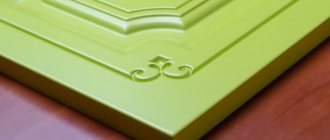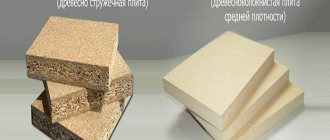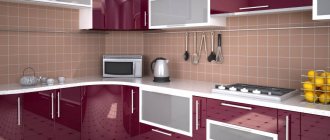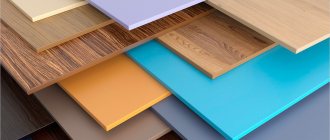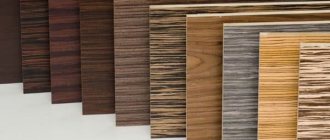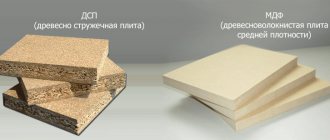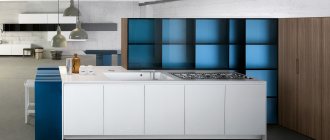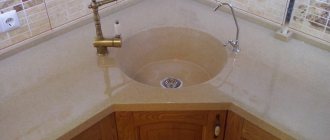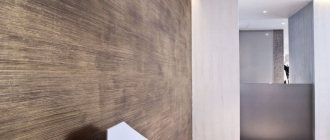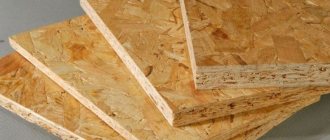Typically, MDF or laminated chipboard is used in furniture production. Although they have good aesthetic features, as well as a wide selection of colors, it is important to understand that in furniture these boards are initially used as a base. And one or another wear-resistant coating is already applied on top of it.
What is better than MDF or laminated chipboard largely depends on their tasks. Laminated chipboard or chipboard are no less in demand, and the price is significantly lower than that of MDF.
To understand which material to choose laminated chipboard or MDF and decide what is better for the kitchen and what is better for the bathroom, you must first find out what is the difference between them, what is the difference, what is furniture made of laminated chipboard and MDF, what are the pros and cons of the materials.
What is MDF
The material received its unusual name due to its abbreviation. The full name is “finely dispersed fraction”.
How to distinguish MDF from chipboard?
First, let's figure out how these names are deciphered. MDF is a fine wood fraction, and chipboard is a laminated chipboard. Both are made from wood waste, but the properties of these materials are different. Chipboard is made from larger chips. Therefore, to distinguish it from MDF, it is enough to look at the cut and pay attention to the structure. If you clearly see sawdust there, you have chipboard in front of you.
Production
To produce both materials, wood production waste is used: knots, branches, crooked trunks, trimmings.
All these materials turn into small chips, which subsequently become the base of MDF or chipboard.
And here lies the first difference between these two materials: For laminated chipboard, the chips are made quite large; for MDF, the blanks are crushed to the smallest possible size.
The second difference is related to the process of combining sawdust and shavings into a single mass:
- For more modern material, the hot pressing method is used;
- For the manufacture of chipboards, formaldehyde resins are used, which are not particularly safe.
At the same time, MDF already has a smooth and soft structure, completely ready for furniture production; laminated chipboard requires additional sanding.
Recommendations for caring for kitchen furniture
A lot of grease and dust settle on kitchen surfaces, so they need constant care. The headset should be cleaned according to the manufacturer's instructions.
You need to care for the furniture carefully so as not to damage the coating. Designers recommend following certain rules to achieve maximum lifespan of the headset.
Tips for caring for kitchen furniture:
- Do not use abrasive detergents, soda, solvents, or hard tools for cleaning.
- To remove oily or stubborn stains, use substances with ammonia.
- Wooden and laminated surfaces are cleaned with a soft cloth, onto which a neutral product is applied.
- For shine, facades are rubbed with compounds containing beeswax.
- Special aerosols are used to clean wooden furniture. There is also a dry cleaning method using a vacuum cleaner with a special attachment.
- The varnished surface needs protection from direct exposure to sunlight.
- Kitchen furniture should not be wiped with a damp cloth.
- The interior surfaces of the drawers are cleaned with a cloth moistened with a small amount of cleaning agent.
- Aluminum profiles are cleaned with liquid detergents or denatured alcohol.
- Make sure that there is no accumulation of water on kitchen surfaces, otherwise the plastic will swell and the panels may come off.
Manufacturers offer a wide range of kitchen furniture. When choosing products, you should rely on your preferences and tastes. The differences in the characteristics of the materials are insignificant, and both options are excellent for making a high-quality and beautiful kitchen set.
Advantages of materials
Both materials are in great demand due to their undoubted advantages. These include:
- A wide selection of colors and patterns helps to create furniture suitable for decorating a wide variety of rooms.
- Durability. The materials are quite resistant to mechanical damage and are not susceptible to invasion by bugs and other unwanted inhabitants of natural wood.
- Hygiene. The coating of both materials tolerates wet cleaning and the use of household chemicals well.
- Durability. If you follow simple rules, the materials will last for quite a long time, without requiring additional efforts to maintain an attractive appearance.
- Nice price. Unlike wood, MDF and laminated chipboard are quite available for purchase as part of cabinet furniture, and modern films make them practically indistinguishable from natural materials.
Requirements for kitchen furniture materials
The kitchen set occupies the bulk of the space, so the color of the furniture affects the overall perception of the interior. The first requirement for facades lies in the design plane: their shade must correspond to the overall style of the kitchen and fit harmoniously into the room.
The second point concerns technical issues. The operating conditions of surfaces in the kitchen are quite harsh: they are always in contact with fat, water, sharp objects and hot dishes. When buying furniture, you need to take into account all the nuances.
Basic requirements for materials:
- Appearance. Households spend a lot of time in the kitchen, so the aesthetic component of the facades plays an important role.
- Environmental friendliness. In the room, elevated temperatures often prevail in the area of the stove, and raw materials should not emit harmful substances when heated.
- Strength. Kitchen surfaces are heavily used and therefore must be resistant to chemical, mechanical and thermal damage.
- Easy care. Facades must be cleaned well and quickly, resist stains and be easily restored.
- Price. It is more profitable to buy expensive furniture because it is made with high quality and will last longer.
When choosing a product, you should take into account both the decorative component and the technical characteristics of the raw materials.
Advantages of MDF
At the same time, a more modern coating has additional attractive properties.
It:
- Has high strength and resistance to chipping;
- Less susceptible to moisture;
- Suitable for creating complex designs and carvings.
Difference between panels
Despite the popularity of both types of slabs, each of them occupies its own niche in the furniture business. The materials differ:
By density
- MDF is a dense and moisture-resistant material. Its structure is strong and lends itself to fine processing. Used in carved cabinets, headboards and other places where grace and fine lines are required. Products made from MDF are durable and massive.
- Laminated chipboard is a loose material that strongly attracts moisture. It has a durable façade surface, but is inferior to MDF in terms of fracture strength. The material suffers in the fastening areas due to frequent disassembly and assembly or dragging of pieces of furniture. Laminated chipboard is 2 times inferior in strength to fibreboard. At the same time, the laminated protection makes the chip structure stronger, while at the same time protecting it from moisture and temperature. Therefore, laminated chipboards are popular in the manufacture of kitchen sets and bathroom furniture.
Environmentally friendly
- MDF is close to wood in nature and is allowed for all premises.
- Laminated chipboard contains toxic components (formaldehyde), which limits its use in areas where children and patients are present.
By design
- The design of MDF panels is limited.
- Laminated chipboard has many colors and textures due to the laminated coating. Chipboard panels are used to make cabinet furniture with an imitation of any wood.
By cost
- MDF is expensive. Used in the manufacture of luxury furniture.
- The price of laminated chipboard is more affordable. The facades of economy-class cabinet furniture are mainly assembled from laminated boards.
Disadvantages of materials
The main disadvantage is the flammability of the materials. However, a similar drawback is present in all objects created from wood or its derivatives.
The second unpleasant moment will be the formation of cracks or chips when heavy objects fall onto the surface or careless handling of sharp objects.
What material to choose for the bedroom and nursery?
A bed is a place where you spend at least 6-8 hours every day. Obviously, constantly inhaling formaldehyde fumes will harm you. Therefore, buy or order a bed for your bedroom made of MDF. The same applies to bedside tables and tables.
But the cabinets and chests of drawers at the opposite end of the bedroom can be made of laminated chipboard. Or consider a combined option: the material of the internal shelves and cabinets is laminated chipboard, and the beautiful facades are made of MDF.
The choice for a children's room is obvious - safe MDF. But if the child is no longer a preschooler, then you can buy (order) a desk and a cabinet made of laminated chipboard.
Comparison of main characteristics
Despite almost the same composition and similar characteristics, the materials have slightly different performance properties:
- Density. This indicator is slightly higher for MDF, so it becomes stronger and more resistant to damage.
- Moisture resistance. Laminated chipboard has much better performance than its untreated predecessor. But it is also inferior to MDF in this property. However, the latter material also does not really like water. The areas that suffer the most from moisture are not very neatly sealed joints and corners. Therefore, when purchasing, you should pay special attention to the edges of the products.
- Durability. This indicator is influenced by strength, moisture resistance and ability to withstand impacts. All these characteristics are higher in MDF, so a panel made from fine wood fraction still has a chance to live longer. In addition, chipboard does not really like re-screwing screws or hammering nails.
- Environmental friendliness. Formaldehyde, which is part of chipboard, can release dangerous fumes when heated strongly, so it is considered a more harmful material. But in ordinary life it is completely safe. And yet, if there is a choice, it is better to give preference to MDF.
- Flammability. In terms of this indicator, laminated chipboard wins; it is more resistant to heat and fire.
- Price. In terms of loyalty to the wallet of the future owner, laminated chipboard is the leader, but due to its longer service life, this saving may be dubious.
Appearance. In appearance, both materials are not very different from each other. However, MDF has more possibilities for creating a more attractive design. The material can withstand milling and creating patterns, and can be finished with natural veneer. So in beauty it is not much different from solid wood.
Most often, products made from chipboard are purchased for quick furnishing of premises and subsequent replacement with higher quality items. MDF remains an investment for a longer period.
What to choose
You can choose different materials for different rooms. It depends on the wishes of the owners, their capabilities, as well as the purpose of the room.
- Living room. The room is not subject to changes in temperature and humidity, so both materials will look equally good here. However, preference is still given to the more resistant and durable MDF, which also has more sophisticated patterns.
- Bedroom and children's room. For both premises, environmental friendliness plays a major role, so if it is not possible to use natural wood, the choice is still made in favor of MDF.
- Kitchen. The undisputed leader is MDF, which is more resistant to moisture and temperature changes. Laminated chipboard is used if you need to leave the room quickly, but there is not much money.
- Bathroom and toilet. Both materials are not very suitable for furnishing these rooms due to their dislike of moisture. But if there is a need to equip a “wet” room with a set of wood waste, then choose the more moisture-resistant and durable MDF. In this case, special attention is paid to finishing the edges of the product.
- Hallway. Usually there is not too much load on the furniture in the hallway. For the entrance area, it is still better to buy furniture made of MDF, but laminated chipboard will also work well.
In which kitchen interior is it better to use MDF, and in which laminated chipboard?
If you plan to design a kitchen in a certain style, then you need to take into account differences in the properties of materials. Designers advise adhering to the following recommendations.
- For a kitchen in a classic style, MDF without a paintable finish is ideal; you can choose the desired color for it, and make some elements of the kitchen furniture shaped.
- In a high-tech kitchen, everything is strictly and concisely, without carved elements, so you can choose laminated chipboard.
- As in the classics, for a kitchen in the Provence style it would be ideal to use MDF with a smooth, fine-grained surface for painting.
- In laminated chipboard, the quality of the glossy finish is slightly better and is more suitable for an art deco style kitchen. But MDF will also be quite good in this design.
